
|
 |
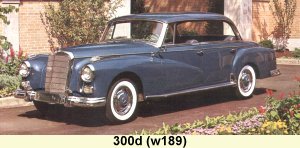 For those people who bought
the old 300d (W186 and W189) models and now were in the market for something new, Mercedes
decided to introduce a long wheelbase version of its 300SE (Mercedes named it an
'extended' wheelbase car). The normal wheelbase 300SE did not provide the same interior
space as the old 300d did, especially for those 'chauffer-driven' rear passengers.
Mercedes did offer a suitable limousine, the massive 600 or W100, but this model was so
crammed with technical novelties that its price was to high for those who were not crowned
heads. Customers who wanted a convertible sedan, which was possible with the 300d, had to
choose a 600 because the 300SE LWB was not offered as a convertible. Because the
additional space made the car some 50 kg heavier, Mercedes fitted the car with a lower
first gear and a larger 82 liter fuel tank instead of the standard 62 liter which at least
lengthened the touring range. This new tank was also fitted to the standard wheelbase
300SE. For those people who bought
the old 300d (W186 and W189) models and now were in the market for something new, Mercedes
decided to introduce a long wheelbase version of its 300SE (Mercedes named it an
'extended' wheelbase car). The normal wheelbase 300SE did not provide the same interior
space as the old 300d did, especially for those 'chauffer-driven' rear passengers.
Mercedes did offer a suitable limousine, the massive 600 or W100, but this model was so
crammed with technical novelties that its price was to high for those who were not crowned
heads. Customers who wanted a convertible sedan, which was possible with the 300d, had to
choose a 600 because the 300SE LWB was not offered as a convertible. Because the
additional space made the car some 50 kg heavier, Mercedes fitted the car with a lower
first gear and a larger 82 liter fuel tank instead of the standard 62 liter which at least
lengthened the touring range. This new tank was also fitted to the standard wheelbase
300SE.
|
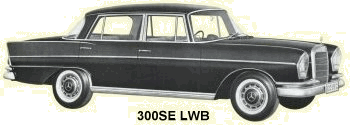 Although this car was a
good replacement for the old 300, it missed a certain grandeur that the old car had.
Customers did not appreciate it that the 300SE LWB had certain similarities with the
cheapest 190 Mercedes had to offer. But this car proved its worth and in fact carved out
its own market, a long wheelbase version of the top model Mercedes saloon became a
permanent feature of the range for the next 30 years. Although this car was a
good replacement for the old 300, it missed a certain grandeur that the old car had.
Customers did not appreciate it that the 300SE LWB had certain similarities with the
cheapest 190 Mercedes had to offer. But this car proved its worth and in fact carved out
its own market, a long wheelbase version of the top model Mercedes saloon became a
permanent feature of the range for the next 30 years.
|

|
Below are the things mentioned that differ from the normal
wheelbase 300SE so for a complete description, please read chapter 5)
1961: The 300SE first. |
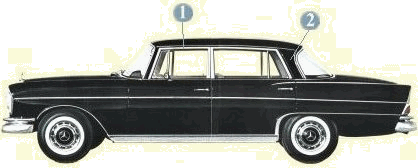
|
  If you think that a 300SE car couldn't have any more chrome
you are wrong. The long wheelbase cars and later normal wheelbase 300SE cars have extra
chrome around their windows. If you think that a 300SE car couldn't have any more chrome
you are wrong. The long wheelbase cars and later normal wheelbase 300SE cars have extra
chrome around their windows.
|
  Mercedes decided to remove the chromed air-vent on the
C-pillar from the car. Although it looks like it has been removed. In fact the LWB car has
an extra panel over the standard air-vent which has a unique chrome strip along the rear
edge. It's hard to tell from just looking at the picture but it's there. Apart from this
it is quite hard to tell the normal wheelbase 300 apart from the long wheelbase 300. Mercedes decided to remove the chromed air-vent on the
C-pillar from the car. Although it looks like it has been removed. In fact the LWB car has
an extra panel over the standard air-vent which has a unique chrome strip along the rear
edge. It's hard to tell from just looking at the picture but it's there. Apart from this
it is quite hard to tell the normal wheelbase 300 apart from the long wheelbase 300.
|
 |

|
Here also are things mentioned in which the 300SE LWB differ
from a normal wheelbase 300SE. So for a more detailed description of the interior, please
read chapter 5) 1961: The 300SE first. |
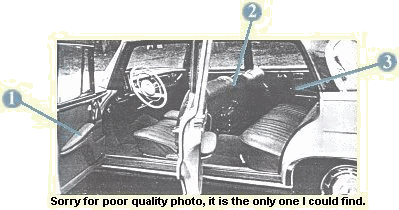
|
 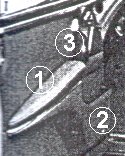 Although the interior was much the same as that of a standard
wheelbase 300SE, there is one thing that all LWB 300's have and standard wheelbase 300's
don't have: the extra padded armrests (no. 1). In the front as well as in the back,
passengers could enjoy the luxury of the large cushion-like armrest. Although the interior was much the same as that of a standard
wheelbase 300SE, there is one thing that all LWB 300's have and standard wheelbase 300's
don't have: the extra padded armrests (no. 1). In the front as well as in the back,
passengers could enjoy the luxury of the large cushion-like armrest.
The doorpockets (no. 2) are more integrated into the design of the different armrests.
They are now simple open doorpockets.
|
| The extra armrest, however, made it necessary to give the driver that extra doorhandle
(no. 3) which also could be found on the other doors. |
 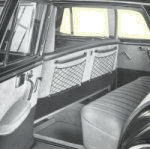 The extra length, 10 cm, was entirely for the benefit of the
rear passengers. Mercedes even printed a special brochure to give future rear passengers a
glimps of their space. Besides the extra space, the longer rear doors provided passengers
to enter and leave the car with more ease. Upon special request, an electrically operated
partition between driver and the rear of the car could be installed. Note the small switch
in the middle of the partition to operate the glass part of the partition and the two
handles, one for each passenger. The extra length, 10 cm, was entirely for the benefit of the
rear passengers. Mercedes even printed a special brochure to give future rear passengers a
glimps of their space. Besides the extra space, the longer rear doors provided passengers
to enter and leave the car with more ease. Upon special request, an electrically operated
partition between driver and the rear of the car could be installed. Note the small switch
in the middle of the partition to operate the glass part of the partition and the two
handles, one for each passenger.
|
 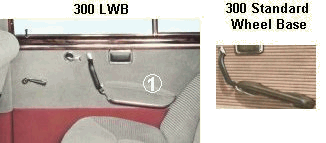 Here you can clearly see the difference in armrests (no. 1)
between the standard wheelbase 300 and the long wheelbase 300. The armrests on the LWB
have definitely lost their function as doorhandle. They are there exclusively to enhance
the comfort for all the passengers. Here you can clearly see the difference in armrests (no. 1)
between the standard wheelbase 300 and the long wheelbase 300. The armrests on the LWB
have definitely lost their function as doorhandle. They are there exclusively to enhance
the comfort for all the passengers.
|